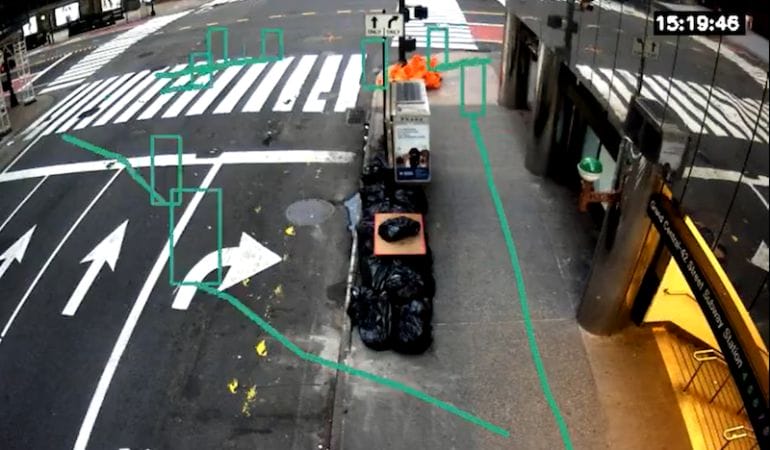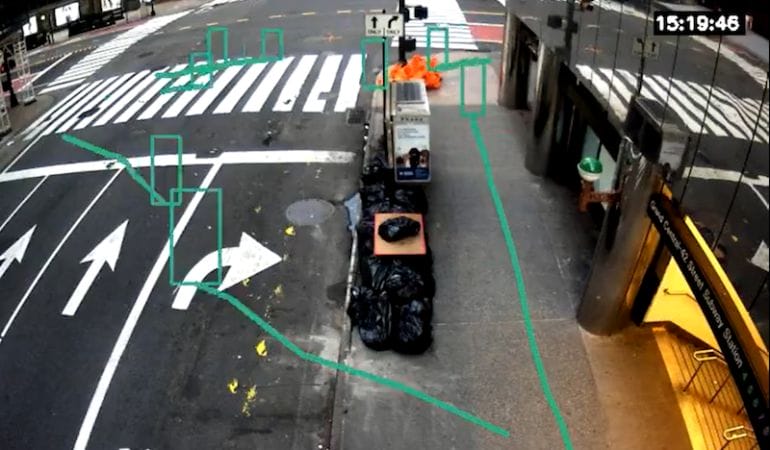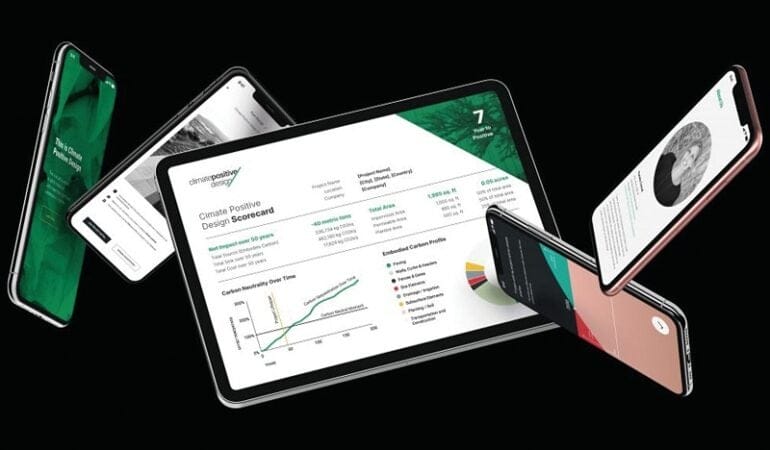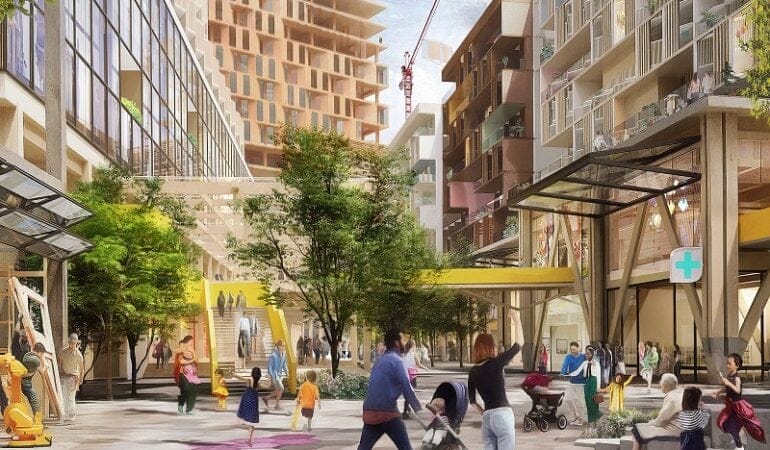Por lo general, los proyectos de desarrollo de 5 hectáreas no tienden a llamar la atención nacional ni internacional. Pero en el caso de Quayside, un lote junto al lago Ontario, en Toronto, esto fue diferente. Hace dos años, Waterfront Toronto (la entidad gubernamental que supervisa el redesarrollo y la reconfiguración de una franja más amplia de propiedades junto al río Don que incluye a Quayside) incorporó a Sidewalk Labs como socio privado. Sidewalk es subsidiaria de Alphabet, empresa matriz de Google, y prometió invertir US$ 50 millones en el emprendimiento. La empresa parecía ideal para ayudar a hacer de Quayside un prototipo de vecindario de “ciudad inteligente”, y elaboró planes ambiciosos.
También causó bastante controversia, y por momentos pareció que la sociedad misma terminaría por implosionar. Al momento de esta publicación, esta amenaza parece haber desaparecido, al menos por un tiempo. Toda la fricción tuvo un resultado inesperado: Quayside terminaría siendo un prototipo mucho más valioso para la planificación de ciudades inteligentes de lo que se había pensado.
Esto no se debe a lo que se construyó (que, a la fecha, es nada), sino más bien a la manera en que el camino escabroso ha aclarado los problemas centrales de las ciudades inteligentes, que se deben resolver antes de que se pueda construir, no solo en Toronto, sino en cualquier zona urbana. Si bien es difícil encontrar un proyecto de ciudad inteligente que sea tan cabal como pretende ser Quayside, se están desarrollando muchos a escala más limitada, desde el “corredor de ciudad inteligente” de Kansas City, centrado en una línea de tranvía de tres kilómetros, hasta el programa LinkNYC (también de Sidewalk Labs), que reemplaza los teléfonos públicos de la ciudad de Nueva York por puestos estrechos habilitados para wifi.
Probablemente, el mayor problema que se debe solucionar es la privacidad. Esto puede resultar intuitivo, e incluso Sidewalk Labs declaró en la propuesta inicial estar al tanto y ser consciente de las preocupaciones acerca de la privacidad. Dicha propuesta incluyó muchas ideas de tecnología avanzada que se esperarían de una entidad conectada con Google, desde bicisendas con calefacción hasta robots autónomos para entregas. Muchos de los elementos que se propusieron dependían de que unos sofisticados sensores recopilaran datos y gestionaran la eficiencia para todo, desde la recolección de basura hasta el tráfico y la iluminación.
Si bien la propuesta de Sidewalk tenía en cuenta la privacidad, aparentemente la empresa recibió con sorpresa las críticas de que demasiada discreción quedaba en manos de proveedores tecnológicos privados. Sin embargo, alguien no se sorprendió: Ann Cavoukian, ex comisionada de privacidad en Ontario, prominente defensora de la privacidad que Sidewalk había incorporado al comité asesor, pero que renunció de inmediato.
Hoy, Cavoukian es directora ejecutiva de la consultora Global Privacy & Security by Design Centre, especialista en privacidad, y explica que reconoce el valor potencial de recolectar datos para dar forma a un vecindario o una ciudad. Pero, en esencia, cree que, en el contexto de la ciudad inteligente, garantizar la privacidad es una decisión a nivel de planificación que es mejor dejar para el sector público. “La tecnología, los sensores, siempre estarán encendidos”, dice. “No hay una instancia en que las personas puedan dar o no dar su consentimiento. No tienen opción”.
Defiende específicamente lo que denomina estrategia de “privacidad por diseño”, que “limpia” los datos cuando se los recopila. Por ejemplo, las cámaras o los sensores que recogen datos de tráfico también podrían detectar números de matrícula. Si se hiciera como indican Cavoukian y otros defensores de la privacidad, sencillamente no se recolectaría ese nivel de datos personales. “Se sigue obteniendo el valor que dejan los datos [totales]”, dice. “Pero no corres riesgos de privacidad porque los datos se desidentificaron”. La esencia de la privacidad por diseño es que prioriza el interés público por sobre el uso privado de datos; Cavoukian señaló como modelo el Reglamento General de Protección de Datos de la Unión Europea, que protege estrictamente la privacidad de los individuos y, desde que se implementó en 2018, ha obligado incluso a las empresas tecnológicas más grandes a realizar ajustes.
Sidewalk Labs propuso recolectar grandes paquetes de datos en una especie de “custodia”, y alentar a los proveedores privados a anonimizar los datos. Para los críticos como Cavoukian, esto postergó las decisiones sobre privacidad hasta un punto tardío en el proceso: luego de planificar e implementar; más que un punto de partida, son una acotación. Según una encuesta, el 60 por ciento de los residentes de Toronto que conocían el plan no confiaban en la recolección de datos de Sidewalk. Ambas partes siguen ultimando detalles, pero por ahora hemos acordado que los datos recogidos por sensores se tratarán como un activo público, y no privado (Sidewalk Labs no respondió al pedido de entrevista).
La propuesta de Toronto fue controversial por otros motivos. Destaca el hecho de que buscó supervisar mucho más que el terreno original de 5 hectáreas, y tentó con la posibilidad de ubicar una sede central canadiense de Google en la costanera de la ciudad, como parte de una estrategia que otorgaría a Sidewalk laxitud sobre 77 hectáreas de propiedades con potencialidad lucrativa. Esta propuesta se rechazó, pero incentivó un debate útil acerca de las ciudades inteligentes y la igualdad.
Jennifer Clark, profesora y jefa de la Sección de Planificación Regional y de Ciudades en la Escuela de Arquitectura Knowlton, Facultad de Ingeniería de la Universidad Estatal de Ohio, estudió las labores de ciudades inteligentes en todo el mundo. Es autora de Uneven Innovation: The Work of Smart Cities (Innovación despareja: el trabajo de las ciudades inteligentes), que publicó Columbia University Press en febrero de 2020. Ella explica que las empresas tecnológicas y las entidades gubernamentales o de planificación llegan a estas colaboraciones con perspectivas diferentes. Dice que las empresas como Sidewalk Labs, que se dedican a las nuevas tecnologías en la ciudad, “vienen de una orientación particular de pensar quién es el ‘usuario’. Piensan mucho a partir de un modelo de consumidor, y, en esencia, los usuarios y los consumidores son lo mismo. En las ciudades, los planificadores no piensan así. Los usuarios son ciudadanos”.
Del mismo modo, las empresas que diseñan tecnología pensada para hacer que una ciudad sea “inteligente” buscan un modelo de ingresos que no solo financie un proyecto determinado, sino que termine por demostrar que es rentable; esto orienta la naturaleza de sus productos y servicios prototípicos, que, con el tiempo, se podrían aplicar en otras partes. Clark destaca que un elemento poco debatido en el fenómeno de las ciudades inteligentes es la “implementación despareja”. Se espera que Quayside y el redesarrollo más amplio de la costanera donde se encuentra generen como resultado propiedades de alto valor, que utilice y frecuente un sector demográfico atractivo para las empresas.
“Se presupone que, si se hacen estos distritos de desarrollo urbano, se experimenta con el modelo, se logra un buen modelo, y luego se lo implementa de forma extensiva, entonces hay igualdad”, dice Clark. Pero en la práctica, suele “no haber un camino para eso”. Sean cuales sean las innovaciones que surgen, tienden a repetirse en contextos demográficos similares.
Lo que suele subyacer a esta dinámica es una especie de desequilibrio de poder. La parte privada de una sociedad de desarrollo suele estar muy bien financiada y tener la posibilidad de ofrecer incentivos económicos y, por lo tanto, básicamente, establecer los términos; la parte pública puede tener menos recursos y ser menos sofisticada en la evaluación o implementación total de la tecnología de vanguardia. Pero Clark observa que, en este caso, la historia de Quayside (que menciona en su libro) podría ser un tanto distinta.
“Toronto tiene antecedentes de organización y desarrollo comunitarios”, destaca. “Y allí las organizaciones comunitarias poseen un conocimiento complejo de las prácticas de recolección de datos que se propusieron”. Así, puede que el retroceso en la privacidad y el modo en que se resuelva sean la verdadera ventaja duradera, en particular si se resuelve de un modo que los demás puedan emular.
En esencia, el resultado que quiere Cavoukian es un modelo replicable, que ofrezca pautas para la tecnología y las reglas que esta debe acatar. Ahora está trabajando con Waterfront Toronto, y guarda la esperanza explícita de que Quayside (ya sea con Sidewalk Labs u otros socios al mando) se pueda convertir en una réplica de las versiones de ciudad inteligente orientadas a la vigilancia que están tomando forma en zonas urbanas con tecnología avanzada, desde Shanghái hasta Dubai.
“Queremos ser los primeros en mostrar cómo se puede hacer y ofrecerlo como modelo”, dice. “Queremos una ciudad inteligente con privacidad”.
Rob Walker es periodista; escribe sobre diseño, tecnología y otros temas. Su libro The Art of Noticing (El arte de darse cuenta) se publicó en mayo de 2019.
Imagen: Renderizado de sendero peatonal interior en Quayside, un desarrollo de ciudad inteligente plani cado en la ribera de Toronto. Crédito: Picture Plane para Heatherwick Studio para Sidewalk Labs.










